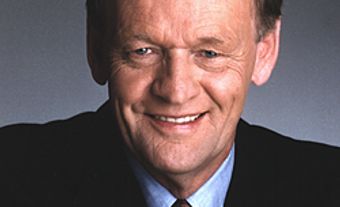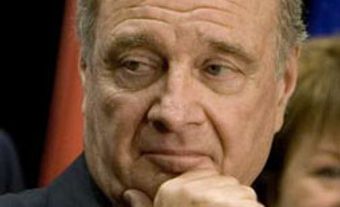Lester Bowles (“Mike”) Pearson, PC, OM, CC, OBE, prime minister 1963–68, statesman, politician, public servant, professor (born 23 April 1897 in Newtonbrook, ON; died 27 December 1972 in Ottawa, ON). Lester Pearson was Canada’s foremost diplomat of the 1950s and 1960s. He formulated the basics of the country’s postwar foreign policy; particularly its involvement in NATO and the United Nations, where he served as president of the General Assembly. In 1957, he received the Nobel Peace Prize for his diplomatic efforts in facilitating Britain and France’s departure from Egypt during the Suez Crisis. A skilled politician, he rebuilt the Liberal Party and as prime minister strove to maintain Canada’s national unity. Under his leadership, the government implemented a Canada Pension Plan; a universal medicare system; a unified Armed Forces; and a new national flag.

Early Life and Career
Lester Pearson was the son of a Methodist parson. He spent his childhood moving from one parsonage to another before enrolling in history at the University of Toronto. With the outbreak of the First World War, he enlisted in the Canadian Army Medical Corps. In 1915, he was shipped to Greece to join the Allied armies fighting the Bulgarians. After two years of stretcher-bearing, he transferred to the Royal Flying Corps in England. His military career came to a sudden end when he was hit by a London bus and invalided home.
After earning his BA at the University of Toronto in 1919, Pearson was undecided on a career. He tried law and business, won a fellowship to Oxford, and was hired by the University of Toronto to teach history; he also coached football.
Pearson married and soon had children. Finding a professor’s salary insufficient, he joined the Department of External Affairs (now Global Affairs Canada). By 1928, he had become a perceptive observer and an able writer, both useful qualities in his work. He quickly attracted the attention of his deputy minister, O.D. Skelton.

Representing Canada Abroad
In 1935, Pearson was sent to London as first secretary in the Canadian High Commission. This gave him a front-row seat as Europe drifted towards the Second World War. He was profoundly influenced by what he saw; as a result, he attached great importance to collective defence in the face of dictatorships and aggression.
In 1941, Pearson returned to Canada. He was sent to Washington, DC, as second-in-command at the Canadian Legation in 1942. His easygoing personality and personal charm made him a great success, particularly with the press. In 1945, he was named Canadian ambassador to the United States. He also attended the founding conference of the United Nations (UN) in San Francisco.
Deputy Minister of External Affairs
In September 1946, Pearson was summoned home by Prime Minister Mackenzie King to become deputy minister (or undersecretary) of external affairs. He continued to take a strong interest in the UN; but he also promoted a closer political and economic relationship between Canada and its principal allies, the US and the United Kingdom. ( See also Middle Power.) Pearson’s work culminated in Canada’s joining the North Atlantic Treaty Organization (NATO) in 1949. He strongly supported a Western self-defence organization; he hoped that its existence would discourage aggression by the Soviet Union.

Minister of External Affairs
By the time NATO was in place, Pearson had left the civil service for politics. In September 1948, he became minister of external affairs and subsequently represented Algoma East, Ontario, in the House of Commons. As minister, he helped lead Canada into the Korean War as a contributor to the UN army. In 1952, he served as president of the UN General Assembly, where he tried to find a solution to the conflict. His efforts displeased the Americans; they considered him too inclined to compromise on difficult points of principle.
Pearson’s greatest diplomatic achievement came in 1956. He proposed a UN peacekeeping force as means for easing the British and French out of Egypt during the Suez Crisis. His plan was implemented, and as a reward he received the Nobel Peace Prize in 1957. (See also Timeline: Peacekeeping; Editorial: The Canadian Peacekeeping Tradition.)
Leader of the Liberal Party
By 1957, Pearson was no longer in office. He and the St-Laurent government were widely blamed for not standing by Britain in 1956. The Liberals were defeated and St-Laurent resigned as leader. At a convention in January 1958, Pearson defeated Paul Martin, Sr. to become party leader.
The Liberals faced a Conservative minority government under John Diefenbaker. In his first act as leader of the Opposition, Pearson challenged Diefenbaker to resign and turn the government over to him. Diefenbaker ridiculed the idea; in the subsequent general election, the Liberals were reduced to 49 of the 265 seats in the House of Commons. (See also Elections of 1957 and 1958.)
Pearson began the slow task of rebuilding the party. With the assistance of parliamentary debaters such as Paul Martin and J.W. Pickersgill, as well as party workers such as Walter Gordon, Mitchell Sharp and Maurice Lamontagne, Pearson re-established the Liberals as a national party. In the 1962 general election, Pearson raised the party’s total to 100 seats.
In 1963, the Diefenbaker government collapsed over the issue of nuclear weapons. (See Cuban Missile Crisis.) In the election that February, the Liberals won 128 seats to form a minority government.
Prime Minister 1963–68
Pearson took office on 22 April 1963. His government was expected to be more businesslike than Diefenbaker’s; but it proved instead to be accident-prone and effectively aborted its first budget. Much of Parliament’s time was spent in bitter partisan and personal wrangling, culminating in the great flag debate of 1964. Historian Rick Archbold described that prolonged, heated debate as “among the ugliest in the House of Commons history.” (See also Editorial: The Canadian Flag, Distinctively Our Own.) In 1965, Pearson called a general election but again failed to secure a majority. In the next year, the Munsinger scandal erupted with even more partisan bitterness.
The year 1965 marked a dividing line in Pearson’s administration. Finance Minister Walter Gordon departed, and Jean Marchand and Pierre Trudeau from Quebec became prominent in the Cabinet. Pearson had attempted in his first term to conciliate Quebec and the other provinces with “co-operative federalism” and “bilingualism and biculturalism.” This priority was superseded in his second term by a firm federal response to provincial demands and by the Quebec government’s attempts to usurp federal roles in international relations. When, during his centennial visit, French president Charles de Gaulle uttered the separatist slogan, “Vive le Québec libre” to a crowd in Montreal, Pearson issued an official rebuke; de Gaulle promptly went home. In December 1967, Pearson announced his intention to retire. In April 1968, a Liberal convention picked Pierre Trudeau as his successor.

Legacy
For all its superficial chaos, the Pearson government left behind a notable legacy of legislation: a Canada Pension Plan; a universal medicare system; a unified Armed Forces; and a new national flag. However, its approach to the problem of Canada’s economically disadvantaged regions was less successful. His government’s legacy, which included the Glace Bay heavy-water plant, was decidedly mixed. Not all of these initiatives proved fruitful and some were costly; but they represented the high point of the Canadian welfare state that generations of social thinkers had dreamed about. In retirement, Pearson worked on his memoirs and on a study of international aid for the World Bank.
See also Maclean’s Article: Lester B. Pearson.

 Share on Facebook
Share on Facebook Share on X
Share on X Share by Email
Share by Email Share on Google Classroom
Share on Google Classroom



